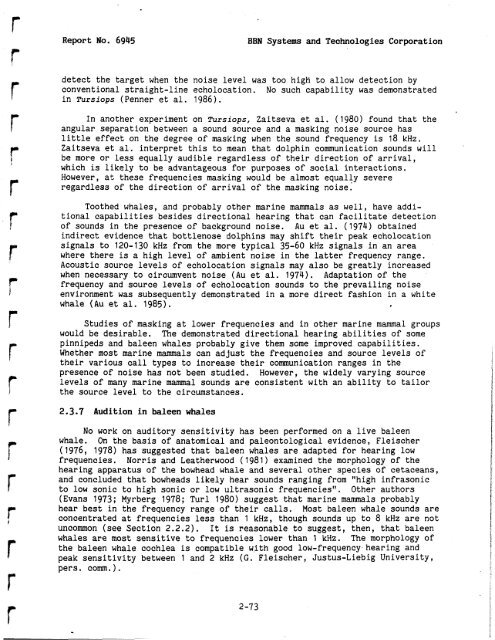Analysis and Ranking of the Acoustic Disturbance Potential of ...
Analysis and Ranking of the Acoustic Disturbance Potential of ...
Analysis and Ranking of the Acoustic Disturbance Potential of ...
You also want an ePaper? Increase the reach of your titles
YUMPU automatically turns print PDFs into web optimized ePapers that Google loves.
Report No. 6945<br />
BBN Systems <strong>and</strong> Technologies Corporation<br />
detect <strong>the</strong> target when <strong>the</strong> noise level was too high to allow detection by<br />
conventional straight-line echolocation. No such capability was demonstrated<br />
in Tursiops (Penner et al. 1986).<br />
In ano<strong>the</strong>r experiment on Tursiops, Zaitseva et al. (1980) found that <strong>the</strong><br />
angular separation between a sound source <strong>and</strong> a masking noise source has<br />
little effect on <strong>the</strong> degree <strong>of</strong> masking when <strong>the</strong> sound frequency is 18 kHz.<br />
Zaitseva et al. interpret this to mean that dolphin communication sounds will<br />
be more or less equally audible regardless <strong>of</strong> <strong>the</strong>ir direction <strong>of</strong> arrival,<br />
which is likely to be advantageous for purposes <strong>of</strong> social interactions.<br />
However, at <strong>the</strong>se frequencies masking would be almost equally severe<br />
regardless <strong>of</strong> <strong>the</strong> direction <strong>of</strong> arrival <strong>of</strong> <strong>the</strong> masking noise.<br />
Too<strong>the</strong>d whales, <strong>and</strong> probably o<strong>the</strong>r marine mammals as well, have additional<br />
capabilities besides directional hearing that can facilitate detection<br />
<strong>of</strong> sounds in <strong>the</strong> presence <strong>of</strong> background noise. Au et al. (1974) obtained<br />
indirect evidence that bottlenose dolphins may shift <strong>the</strong>ir peak echolocation<br />
signals to 120-130 kHz from <strong>the</strong> more typical 35-60 kHz signals in an area<br />
where <strong>the</strong>re is a high level <strong>of</strong> ambient noise in <strong>the</strong> latter frequency range.<br />
<strong>Acoustic</strong> source levels <strong>of</strong> echolocation signals may also be greatly increased<br />
when necessary to circumvent noise (Au et al. 1974). Adaptation <strong>of</strong> <strong>the</strong><br />
frequency <strong>and</strong> source levels <strong>of</strong> echolocation sounds to <strong>the</strong> prevailing noise<br />
environment was subsequently demonstrated in a more direct fashion in a white<br />
whale (Au et al. 1985). .<br />
Studies <strong>of</strong> masking at lower frequencies <strong>and</strong> in o<strong>the</strong>r marine mammal groups<br />
would be desirable. The demonstrated directional hearing abilities <strong>of</strong> some<br />
pinnipeds <strong>and</strong> baleen whales probably give <strong>the</strong>m some improved capabilities.<br />
Whe<strong>the</strong>r most marine mammals can adjust <strong>the</strong> frequencies <strong>and</strong> source levels <strong>of</strong><br />
<strong>the</strong>ir various call types to increase <strong>the</strong>ir communication ranges in <strong>the</strong><br />
presence <strong>of</strong> noise has not been studied. However, <strong>the</strong> widely varying source<br />
levels <strong>of</strong> many marine mammal sounds are consistent with an ability to tailor<br />
<strong>the</strong> source level to <strong>the</strong> circumstances.<br />
2.3.7 Audition in baleen whales<br />
No work on auditory sensitivity has been performed on a live baleen<br />
whale. On <strong>the</strong> basis <strong>of</strong> anatomical <strong>and</strong> paleontological evidence, Fleischer<br />
( 1976, 1978) has suggested that baleen whales are adapted for hearing low<br />
frequencies. Norris <strong>and</strong> Lea<strong>the</strong>rwood (1981) examined <strong>the</strong> morphology <strong>of</strong> <strong>the</strong><br />
hearing apparatus <strong>of</strong> <strong>the</strong> bowhead whale <strong>and</strong> several o<strong>the</strong>r species <strong>of</strong> cetaceans,<br />
<strong>and</strong> concluded that bowheads likely hear sounds ranging from "high infrasonic<br />
to low sonic to high sonic or low ultrasonic frequencies". O<strong>the</strong>r authors<br />
(Evans 1973; Myrberg 1978; Turl 1980) suggest that marine mammals probably<br />
hear best in <strong>the</strong> frequency range <strong>of</strong> <strong>the</strong>ir calls. Most baleen whale sounds are<br />
concentrated at frequencies less than 1 kHz, though sounds up to 8 kHz are not<br />
uncommon (see Section 2.2.2). It is reasonable to suggest, <strong>the</strong>n, that baleen<br />
whales are most sensitive to frequencies lower than 1 kHz. The morphology <strong>of</strong><br />
<strong>the</strong> baleen whale cochlea is compatible w.ith good low-frequencyhearing <strong>and</strong><br />
peak sensitivity between 1 <strong>and</strong> 2 kHz (G. Fleischer, Justus-Liebig University,<br />
pers. comm.).
















